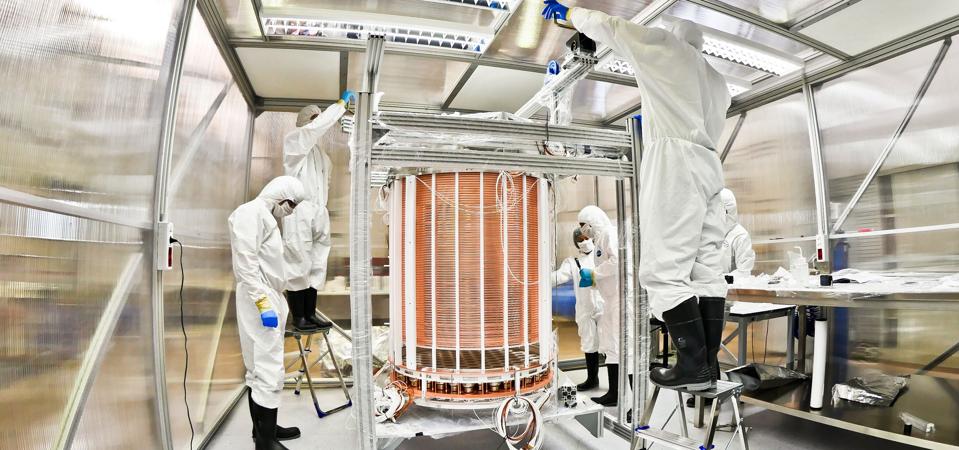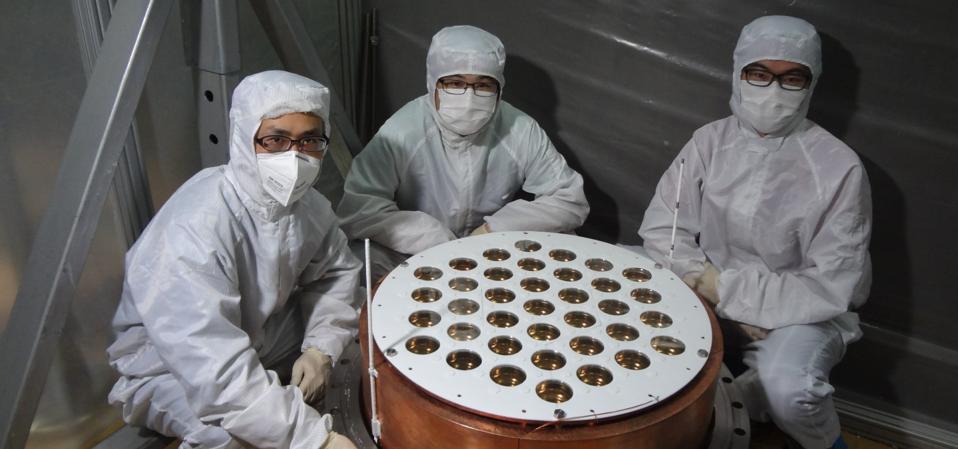
Dark matter is thought to be more prevalent than ordinary matter and found throughout the cosmos. … [+]
ASSOCIATED PRESS
In June 2020, an experiment located in Italy presented evidence suggesting that they may had directly observed dark matter. Now a second experiment conducted in China has announced data that is consistent with the first one. Has dark matter been discovered? That would be a hasty conclusion, but the situation is pretty interesting.
The XENON1T experiment uses over three tons of liquid xenon to search for dark matter. Researchers hope that dark matter in the solar system will pass through the detector and a small fraction of it will interact with the xenon and leave a signal in their detector. Prototypes of XENON1T began operations in 2006, with a series of upgrades, leading to XENON1T. It began operations in 2016.
In June 2020, the researchers announced that they had observed more signals than they expected (285 observed vs. 232 expected). The expected number of signals could be accounted for by known sources. The excess of 53 events could be the signature of dark matter interactions.

Researchers assemble the “time projection chamber,” which is the electronic component of the XENON1T … [+]
XENON1T collaboration
The scientists did not claim that they had observed dark matter, however dark matter of a form called axions was one possible explanation for the excess, although some scientists reject that hypothesis. On the other hand, contamination by radioactive tritium is another possible explanation. A few other exotic origins of the unexpected number of events were also offered as possibilities.
“Hear hooves, expect horses, not zebras” is something medical students are taught as they learn to diagnose patients. The aphorism reminds them that the commonplace is more likely than the exotic. This maxim works well in physics discovery as well. It is simply far more likely that an unexpected observation will have an ordinary origin, rather than being a groundbreaking discovery.
On the other hand, the XENON1T experiment did not have sufficient capability to determine which of the various proposed causes was real. Caution requires that all possibilities be investigated. A follow-on experiment called XENONnT will be able to resolve the mystery, but the XENON experiments aren’t the only dark matter game in town.
PandaX-II is the name of another collaboration of researchers looking for dark matter. It also uses liquid xenon to search for dark matter. The detector is located in Sichuan, China, in a laboratory a full mile and a half underground (2.4 km). This is the deepest underground laboratory in the world.
PandaX-II is smaller than XENON1T, but it collected data for a longer period of time, resulting in about half as much data as XENON1T. The collaboration also has a better handle on the detector’s response to tritium, as it had injected the detector with methane, in which one of the hydrogen atoms was replaced with tritium.

Chinese researchers assemble the PandaX-II detector
PandaX-II
The PandaX-II collaboration recently announced their results. Like XENON1T, they also found an excess of events above expectation. The two experiment’s results were consistent with one another. On the other hand, the PandaX-II experiment’s results were also consistent with an upward statistical fluctuation of known background. In short, the PandaX-II experiment provided welcome support for the earlier observation but was not a definitive confirmation.
Resolving the question will require the next generation of detectors. The Panda collaboration is building PandaX-4T, a detector consisting of six tons of liquid xenon, of which four tons are in the central volume and can be used for dark matter searches. The XENON collaboration is building XENONnT, which will use 8.3 tons of liquid xenon. In addition, a third collaboration, called the LUX-ZEPLIN detector, will use ten tons of liquid xenon. LUX-ZEPLIN is located in an underground facility at the Sanford Underground Research Facility in South Dakota.
Once the various upgraded detectors are made operational and their respective backgrounds are understood, each of them will be able to definitively demonstrate whether the XENON1T experiment has seen dark matter or not. All of these experiments are far along, and it won’t be that long until the question is answered, although Covid has slowed progress.
Understanding the cosmic mysteries that dark matter is proposed to solve is a pressing goal for the physics community. Something makes galaxies rotate too fast and holds clusters of galaxies together. The PandaX-II experiment’s recent measurement gives researchers hope that they are on the right path.
This article is auto-generated by Algorithm Source: www.forbes.com


